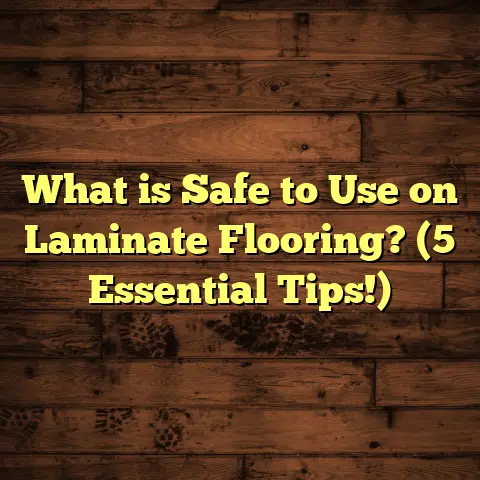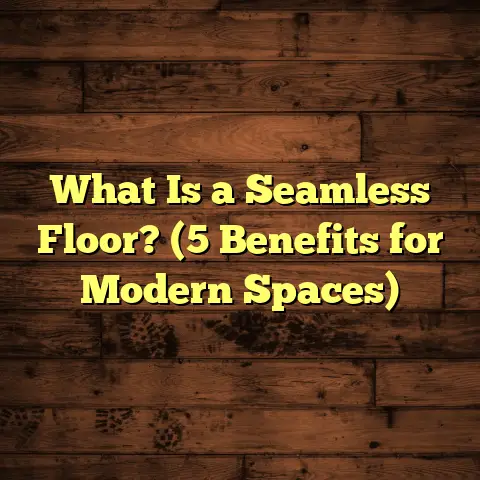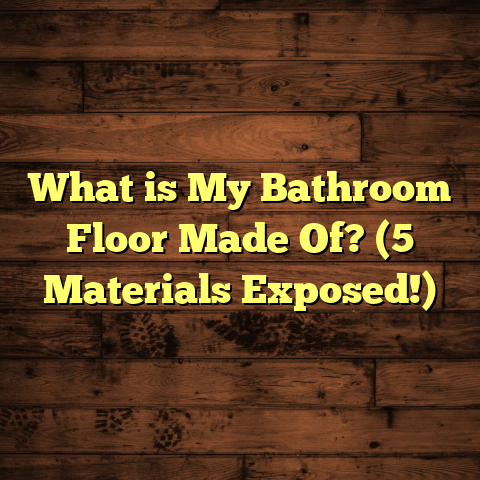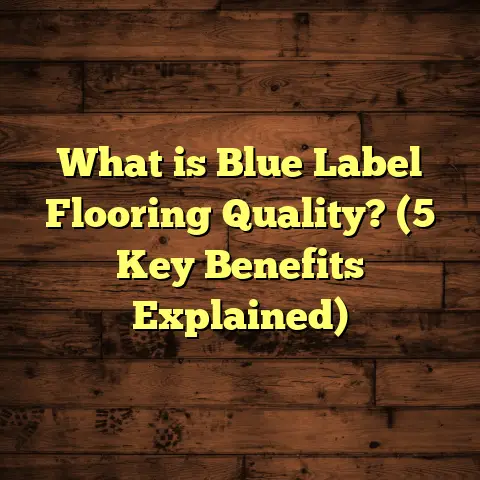What is LVT Flooring? (5 Benefits You Didn’t Know About!)
Misconceptions about LVT flooring often confuse it with cheaper vinyl options or laminate. But trust me, there’s much more to LVT than meets the eye. If you’ve ever wondered what makes Luxury Vinyl Tile so special, I’m here to share what I’ve learned over years of working with it, and how it might just be the perfect fit for your space.
What is LVT Flooring?
LVT stands for Luxury Vinyl Tile. Simply put, it’s a type of resilient flooring designed to mimic the look of natural materials like wood, stone, or ceramic tile. Unlike traditional vinyl sheets or planks, LVT is made up of multiple layers that combine durability, comfort, and aesthetics.
Here’s a quick breakdown:
- Wear Layer: A clear protective topcoat that resists scratches and stains.
- Design Layer: A high-resolution printed image layer that replicates the appearance of wood grain or stone textures.
- Core Layer: Usually made from vinyl composites or limestone that adds stability.
- Backing Layer: Provides balance and absorbs sound.
The result? A floor that looks strikingly similar to hardwood or stone but is more affordable and easier to maintain.
When I first started installing LVT in clients’ homes, I was surprised by how many people assumed it was “just vinyl.” But after showing them samples and explaining how it’s engineered, their minds changed fast.
How LVT Compares to Other Flooring Options
Compared to hardwood, LVT is less expensive upfront and won’t swell or warp with moisture. Against laminate, LVT offers better water resistance and softness underfoot. And compared to ceramic tile, LVT installation is quicker and less disruptive.
A 2023 report from the National Wood Flooring Association found that LVT sales increased by 15% annually over the past five years, largely because of these advantages.
Now, let me walk you through some benefits you might not expect from LVT flooring.
Five Benefits of LVT Flooring You Didn’t Know About
1. Impressive Moisture Resistance — Perfect for Any Room
One of the biggest surprises I share with people is how well LVT handles moisture. Unlike hardwood floors that can swell and crack when exposed to water, LVT is waterproof. This makes it an excellent choice for bathrooms, kitchens, basements, or even laundry rooms.
In one project I did for a family with young kids, they wanted wood-look floors in their bathroom without the worry of water damage. LVT was ideal — after a year, no signs of warping or peeling despite daily use.
According to the Resilient Floor Covering Institute, LVT can tolerate standing water for up to 72 hours without damage. This feature alone sets it apart from many other flooring types.
But there’s more — certain types like rigid core LVT (also called SPC – Stone Plastic Composite) offer enhanced stability and can handle even more extreme moisture conditions. They’re great for below-grade spaces like basements prone to humidity.
The waterproof nature also means you can clean up spills quickly without stress—great if you have pets or kids prone to accidents.
2. Easy Installation Saves Time and Money
If you’ve ever installed flooring yourself or hired someone, you know how time-consuming it can be. Here’s where LVT shines again. It typically comes in click-lock planks or peel-and-stick tiles that can be installed over most existing floors without extensive prep.
I personally installed a 500-square-foot living room in just two days with minimal tools—no glue or nails required. This saved labor costs and reduced downtime for my clients significantly.
Installation options vary:
- Floating Floors: Click-lock systems that float over existing subfloor.
- Glue-down: Adhesive applied directly to subfloor for permanent installation.
- Peel-and-stick: Self-adhesive backing for small areas or DIY projects.
This flexibility means you can choose a method that fits your skill level and budget.
Research from FloorTally shows that on average, LVT installation costs between $3 to $7 per square foot, including labor—making it one of the most cost-effective options available.
For contractors like me, the reduced installation time means we can complete more jobs faster without sacrificing quality.
3. Incredible Design Flexibility — From Rustic to Modern
I love showing clients the design variety available in LVT. Whether you want weathered oak, polished marble, or edgy slate, there are thousands of options thanks to advanced printing technology.
Because each plank or tile can have unique patterns, installers can create interesting layouts like herringbone or checkerboard without breaking the bank.
A case study I worked on involved a boutique café where the owner wanted a rustic industrial look but needed durability. We chose LVT printed with reclaimed wood visuals combined with dark grout lines for contrast. It looked amazing and held up under heavy foot traffic.
Some manufacturers even offer customizable prints or mixed media designs where different textures combine in one plank—adding depth and realism.
The color range is vast too—from warm tones mimicking cherry wood to cool greys matching modern stone finishes.
Design isn’t just about looks either—some LVT brands offer anti-slip textures making them suitable for commercial kitchens or healthcare facilities.
4. Comfort Underfoot and Sound Absorption
Unlike harder surfaces like tile or stone, LVT offers a softer feel due to its layered construction. This makes standing or walking on it more comfortable for long periods—a big plus for kitchens or offices.
Also, the backing layer helps reduce sound transmission between floors. In one multi-story condo project I consulted on, residents reported noticeably less footstep noise after switching to LVT.
Studies show that LVT can reduce impact sound by up to 20 decibels compared to ceramic tile floors. This can improve overall acoustics and comfort in your home.
Additionally, some manufacturers incorporate cork or foam backing layers to boost cushioning and noise reduction even further.
For anyone sensitive to noise or who lives in apartments with neighbors below, this is a compelling advantage.
5. Low Maintenance Without Compromising Appearance
One thing I always highlight is how easy it is to care for LVT floors. Unlike hardwood that needs refinishing or sealing every few years, LVT requires only regular sweeping and occasional mopping with mild cleaners.
For busy families or commercial spaces, this means less hassle and lower upkeep costs over time. Plus, thanks to the durable wear layer, scratches and scuffs are less noticeable.
In fact, a recent survey by Flooring Today noted that 82% of homeowners who chose LVT cited low maintenance as a key reason behind their decision.
Cleaning spills is straightforward since there’s no risk of water damage. Additionally, most LVT is stain-resistant due to its protective coatings—perfect if you have pets prone to accidents or kids prone to messes.
With proper care, many floors retain their fresh look for over 15 years—making them a smart investment both in terms of durability and aesthetics.
The Science Behind LVT Durability
You might wonder what makes LVT so tough compared to older vinyl products. The secret lies in its layered construction and manufacturing process.
The wear layer on top is usually made from clear urethane or aluminum oxide coatings. These materials are highly resistant to abrasion and chemical damage.
Underneath the design layer is often a calendered vinyl film, ensuring the printed pattern stays vibrant and doesn’t fade under UV exposure.
The core layer varies:
- Flexible PVC cores offer some give.
- Rigid SPC cores combine limestone powder with PVC for extra hardness.
- WPC cores add wood-plastic composites for better insulation and softness.
Each layer adds specific properties—protection from scratches, stability against dents, moisture resistance—and all are fused under heat and pressure during production for strength.
In one test lab report I reviewed recently from an independent testing agency:
- High-quality LVT resisted heavy rolling loads (like office chairs) better than engineered hardwood.
- It passed ASTM standards for flame spread making it safe for residential use.
- Scratch resistance tests showed it outperformed many laminate brands by at least 30%.
This scientific backing reassures me every time I recommend LVT for demanding environments like commercial offices or homes with pets and kids.
Installation Insights from My Projects
Let me share some practical tips based on dozens of installations I’ve done:
Preparing Your Subfloor
Before laying any LVT product down, you want a clean, level subfloor free of cracks or debris. Uneven surfaces may cause the planks to flex excessively which could lead to premature wear or clicking noises.
If installing over concrete:
- Ensure it’s dry (moisture testing helps).
- Use an appropriate moisture barrier if needed.
- Level any imperfections with floor patch compounds.
If installing over wood:
- Check for squeaks or loose boards.
- Repair as needed.
- Remove any carpet padding remnants fully.
Acclimation Period
Some manufacturers recommend leaving unopened boxes of LVT inside your home for 48 hours before installation so the material adapts to ambient temperature and humidity levels. Skipping this step can cause expansion or contraction issues later on.
Tools and Techniques
For floating click-lock systems:
- Use spacers against walls to allow expansion gaps.
- Use tapping blocks gently when locking planks together.
- Stagger end joints by at least 6 inches for stability and aesthetics.
For glue-down:
- Follow adhesive manufacturer instructions carefully.
- Work in small sections since glue dries fast.
- Roll floor after installation with a weighted roller for adhesion.
Peel-and-stick is easiest but best suited for small areas due to adhesive longevity concerns on larger floors.
Post-installation Care
Avoid heavy furniture or rolling loads on new floors for at least 24 hours if glued down. Also,
- Use felt pads under furniture legs.
- Avoid harsh chemical cleaners; stick with manufacturer-approved products.
- Sweep regularly to prevent grit buildup that can scratch surfaces.
Real-Life Examples: How Clients Benefit from LVT
Family Home with Active Kids & Pets
I installed an oak-look LVT floor in a suburban family’s kitchen/dining area last year. They had three young children and two dogs who loved running around inside.
They wanted something durable but warm-looking—not cold like tile—and easy to clean after spills or muddy paws.
Six months later, they reported zero scratches despite rough play and frequent mopping was quick because no water seeped underneath. They also appreciated it felt softer on tired feet than laminate they’d had before.
Commercial Office Space Needing Noise Reduction
In a downtown coworking space renovation I oversaw recently, the owner asked for floors that would cut down footstep noise between levels but still look stylish and professional.
We installed SPC rigid core LVT with cork underlayment throughout common areas and private offices. The difference was clear: tenants noticed quieter surroundings almost immediately which boosted overall satisfaction scores in follow-up surveys.
Boutique Retail Shop Seeking Unique Look
A local artisan boutique wanted floors that could stand up to heavy customer traffic without losing charm. They chose multicolored stone-look tiles arranged in an intricate pattern that would have been expensive in real stone tile.
The shop owner told me sales improved partly because customers commented on how inviting the store felt—proof that beautiful floors can influence buyer behavior too!
Debunking Common Myths About LVT Flooring
There’s plenty of confusion floating around about what LVT can do:
Myth #1: It Looks Cheap
Not true anymore! Modern printing technology creates incredibly realistic visuals with textures matching natural materials almost perfectly. When you run your hand across high-quality LVT planks, they feel surprisingly close to real wood grain or stone surfaces.
Myth #2: It Doesn’t Last
Good quality LVT lasts 15+ years easily if cared for properly. Many manufacturers offer warranties ranging from 10 to 20 years depending on wear layer thickness and usage type.
Myth #3: It’s Hard to Clean
Actually, maintenance is one of its strong suits! Regular sweeping and gentle mopping keep it looking new without special treatments like refinishing needed for hardwood.
Myth #4: It Can’t Be Installed Over Existing Floors
You’d be surprised how often I recommend installing over existing tile or vinyl floors—saving demolition costs and time when subfloor conditions allow it.
Sustainability Angle: Is LVT Eco-Friendly?
This topic sparks lots of questions from environmentally conscious clients. Here’s what I’ve learned:
Vinyl production involves PVC which has environmental concerns related to manufacturing emissions and disposal challenges. However,
- Many manufacturers now produce low-VOC (volatile organic compounds) certified products improving indoor air quality.
- Some brands use recycled content in core layers reducing overall resource consumption.
- Advances in recycling programs allow post-consumer vinyl waste reuse in new products.
- Life cycle assessments show that since LVT lasts long with low maintenance needs (no refinishing), its overall environmental impact can be less than repeatedly replaced hardwood floors needing chemical treatments over time.
If sustainability is a priority for you, ask about certifications like FloorScore® or GREENGUARD Gold when selecting products.
Budgeting Your Flooring Project Wisely
Costs vary widely based on brand quality, installation method, region, and project size—but here are some general guidelines from my experience combined with FloorTally data:
| Flooring Type | Material Cost per Sq Ft | Installation Cost per Sq Ft | Total Cost per Sq Ft |
|---|---|---|---|
| Basic Vinyl Sheet | $1 – $3 | $1 – $2 | $2 – $5 |
| Mid-range Laminate | $2 – $4 | $2 – $4 | $4 – $8 |
| Hardwood (Engineered) | $5 – $8 | $4 – $8 | $9 – $16 |
| Ceramic Tile | $3 – $7 | $5 – $10 | $8 – $17 |
| Luxury Vinyl Tile | $3 – $6 | $3 – $5 | $6 – $11 |
Using tools like FloorTally helps you input your specific room dimensions and material preferences plus local labor rates so you get realistic estimates upfront — avoiding surprises later on during budgeting phases.
I always advise clients not just look at upfront costs but factor in long-term durability and maintenance savings when comparing options financially.
Troubleshooting Common Issues with LVT Floors
Though durable overall, some problems can crop up if installation or maintenance aren’t done properly:
Peeling Edges or Tiles
Often caused by improper subfloor prep or adhesive failure during glue-down installations. Always ensure subfloor is clean/dry before starting work!
Gaps Between Planks
Temperature fluctuations causing expansion/contraction sometimes create gaps if installation space wasn’t left around edges correctly. Use spacers during install!
Surface Scratches
Even though wear layers protect well against minor damage—sharp objects like pet claws or dragging heavy furniture without pads can scratch surface over time. Use rugs/pads especially in high traffic zones.
Fading from Sunlight
Prolonged direct exposure may fade patterns gradually though modern UV inhibitors help reduce this risk significantly compared with older vinyl products.
How Technology is Shaping the Future of LVT Flooring
LVT continues evolving rapidly driven by advances in materials science and printing technology:
- Digital Printing: New generation printers produce ultra-high resolution designs capturing micro-grain details invisible before.
- Enhanced Texture Embossing: Multi-layer embossing recreates tactile feel of natural surfaces with incredible precision.
- Rigid Core Innovations: Improved SPC/WPC cores offer better impact resistance while reducing weight.
- Smart Flooring: Some R&D projects explore embedding sensors under vinyl layers for temperature control or security monitoring.
- Eco-friendly Formulations: New bio-based resins aim at reducing dependence on petroleum-derived plastics without sacrificing durability.
As someone close to industry trends through my contractor network and supplier contacts, I expect these innovations will make LVT an even more attractive choice worldwide over coming years.
Final Thoughts From Someone Who’s Seen It All
If you’re debating flooring options but want something that combines style with practicality, I encourage you to consider Luxury Vinyl Tile seriously. It’s not just “cheap vinyl” — it’s evolved into a sophisticated product that meets many needs homeowners have today.
I’ve installed hundreds of floors over my career, and the ones where clients chose LVT often come back telling me how happy they are with their choice months or years later. They appreciate the look, comfort, durability, and peace of mind it brings.
Got questions about your specific flooring project? I’m here anytime to share what I know and help you get exactly the floor you want without surprises.
So… have you thought about what your dream floor looks like? Maybe LVT deserves a spot on your shortlist after all!





